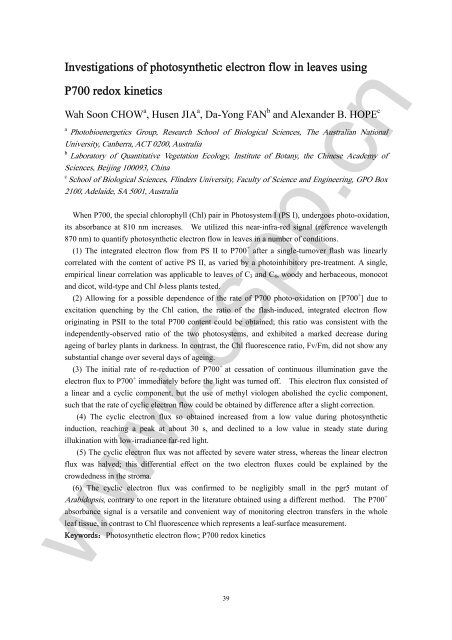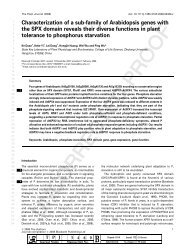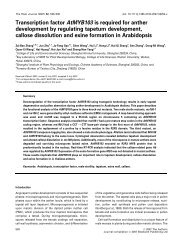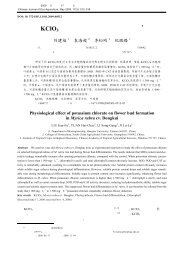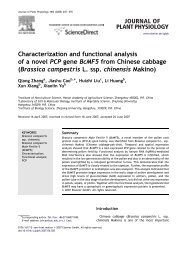Untitled - ä¸å½æ¤ç©ççä¸ååçç©å¦å¦ä¼
Untitled - ä¸å½æ¤ç©ççä¸ååçç©å¦å¦ä¼
Untitled - ä¸å½æ¤ç©ççä¸ååçç©å¦å¦ä¼
Create successful ePaper yourself
Turn your PDF publications into a flip-book with our unique Google optimized e-Paper software.
Investigations of photosynthetic electron flow in leaves using<br />
P700 redox kinetics<br />
Wah Soon CHOW a , Husen JIA a , Da-Yong FAN b and Alexander B. HOPE c<br />
a<br />
Photobioenergetics Group, Research School of Biological Sciences, The Australian National<br />
University, Canberra, ACT 0200, Australia<br />
b<br />
Laboratory of Quantitative Vegetation Ecology, Institute of Botany, the Chinese Academy of<br />
Sciences, Beijing 100093, China<br />
c<br />
School of Biological Sciences, Flinders University, Faculty of Science and Engineering, GPO Box<br />
2100, Adelaide, SA 5001, Australia<br />
When P700, the special chlorophyll (Chl) pair in Photosystem I (PS I), undergoes photo-oxidation,<br />
its absorbance at 810 nm increases. We utilized this near-infra-red signal (reference wavelength<br />
870 nm) to quantify photosynthetic electron flow in leaves in a number of conditions.<br />
(1) The integrated electron flow from PS II to P700 + after a single-turnover flash was linearly<br />
correlated with the content of active PS II, as varied by a photoinhibitory pre-treatment. A single,<br />
empirical linear correlation was applicable to leaves of C 3 and C 4 , woody and herbaceous, monocot<br />
and dicot, wild-type and Chl b-less plants tested.<br />
(2) Allowing for a possible dependence of the rate of P700 photo-oxidation on [P700 + ] due to<br />
excitation quenching by the Chl cation, the ratio of the flash-induced, integrated electron flow<br />
originating in PSII to the total P700 content could be obtained; this ratio was consistent with the<br />
independently-observed ratio of the two photosystems, and exhibited a marked decrease during<br />
ageing of barley plants in darkness. In contrast, the Chl fluorescence ratio, Fv/Fm, did not show any<br />
substantial change over several days of ageing.<br />
(3) The initial rate of re-reduction of P700 + at cessation of continuous illumination gave the<br />
electron flux to P700 + immediately before the light was turned off. This electron flux consisted of<br />
a linear and a cyclic component, but the use of methyl viologen abolished the cyclic component,<br />
such that the rate of cyclic electron flow could be obtained by difference after a slight correction.<br />
(4) The cyclic electron flux so obtained increased from a low value during photosynthetic<br />
induction, reaching a peak at about 30 s, and declined to a low value in steady state during<br />
illukination with low-irradiance far-red light.<br />
(5) The cyclic electron flux was not affected by severe water stress, whereas the linear electron<br />
flux was halved; this differential effect on the two electron fluxes could be explained by the<br />
crowdedness in the stroma.<br />
(6) The cyclic electron flux was confirmed to be negligibly small in the pgr5 mutant of<br />
Arabidopsis, contrary to one report in the literature obtained using a different method. The P700 +<br />
absorbance signal is a versatile and convenient way of monitoring electron transfers in the whole<br />
leaf tissue, in contrast to Chl fluorescence which represents a leaf-surface measurement.<br />
www.cspp.cn<br />
Keywords:Photosynthetic electron flow; P700 redox kinetics<br />
39


